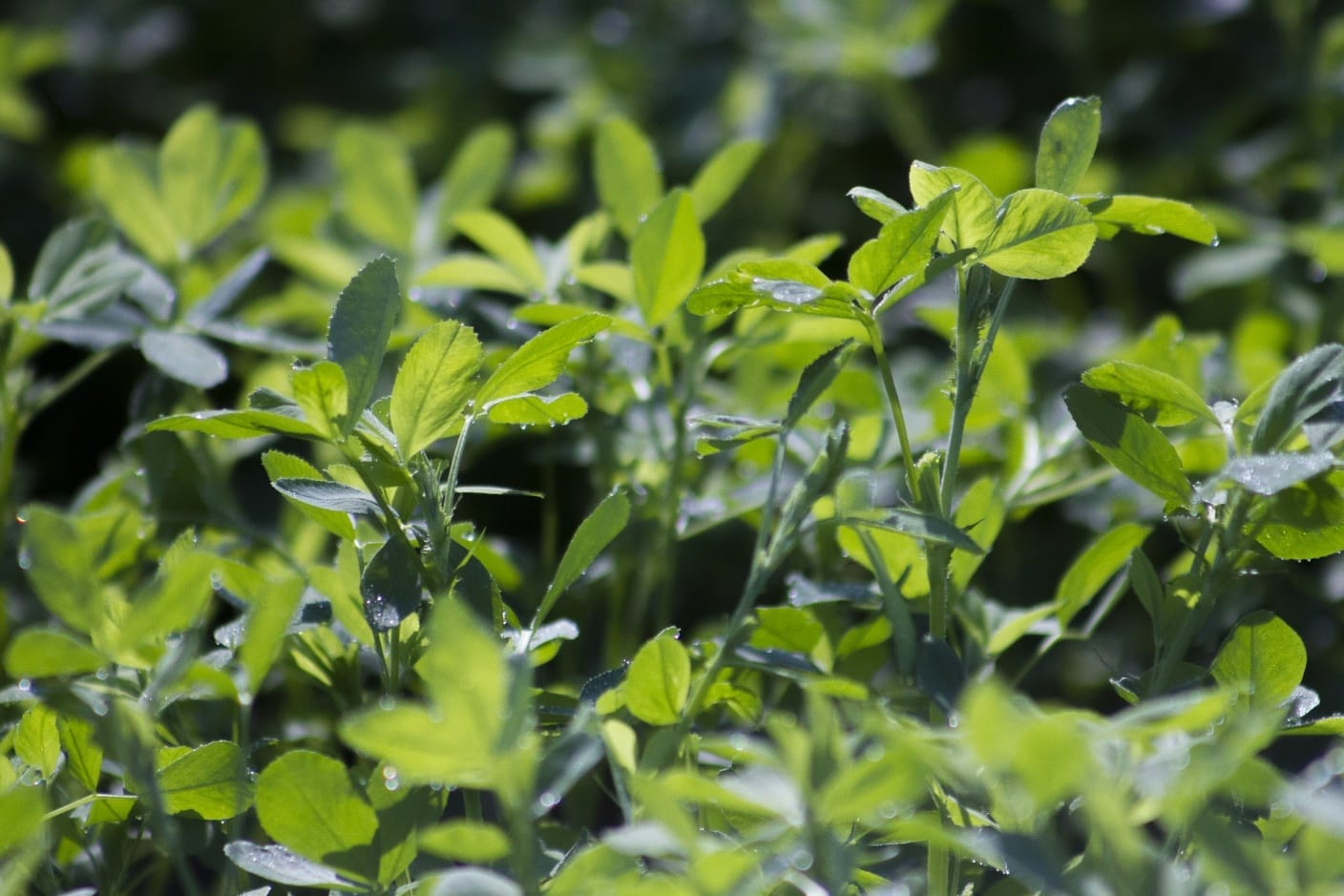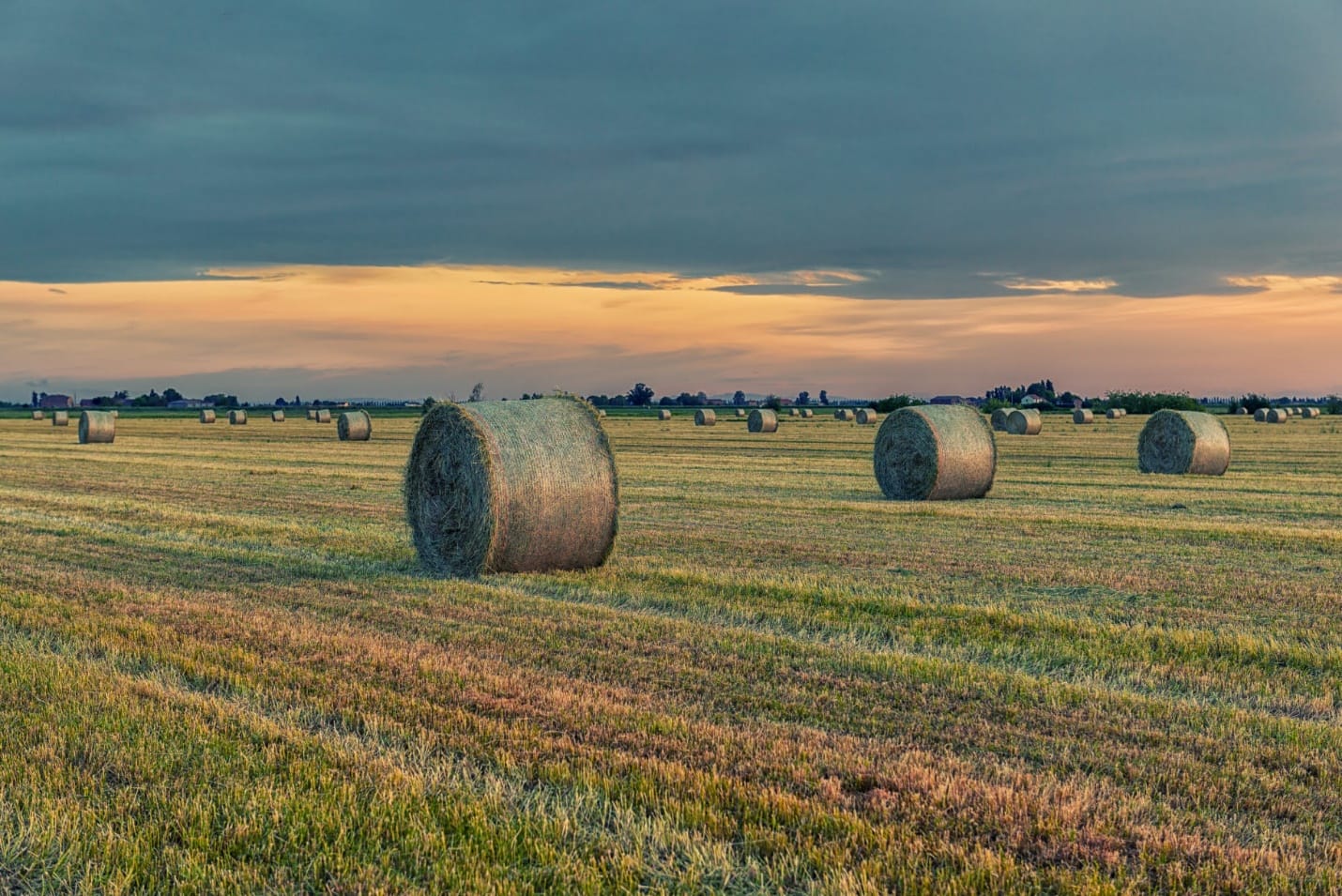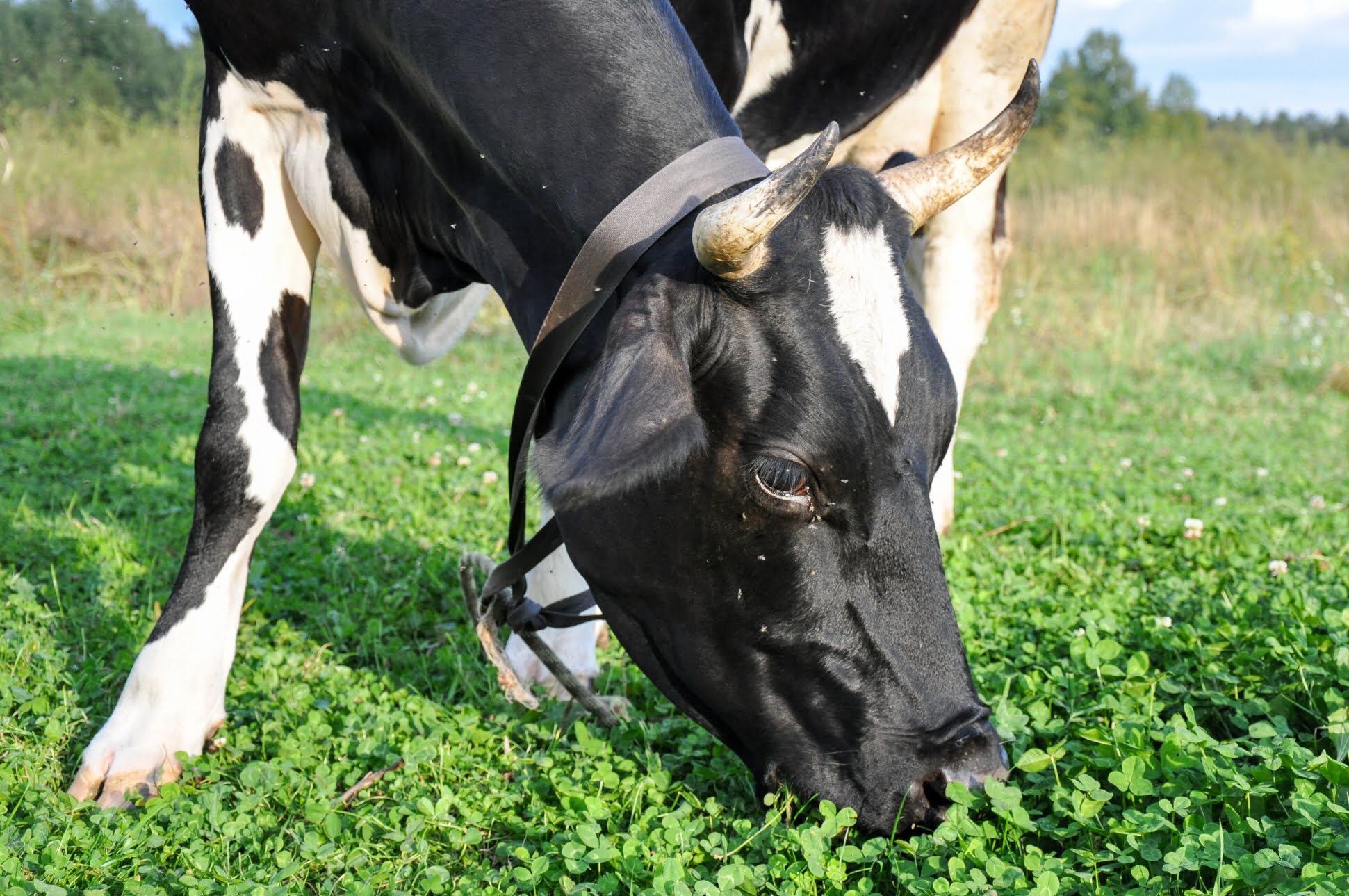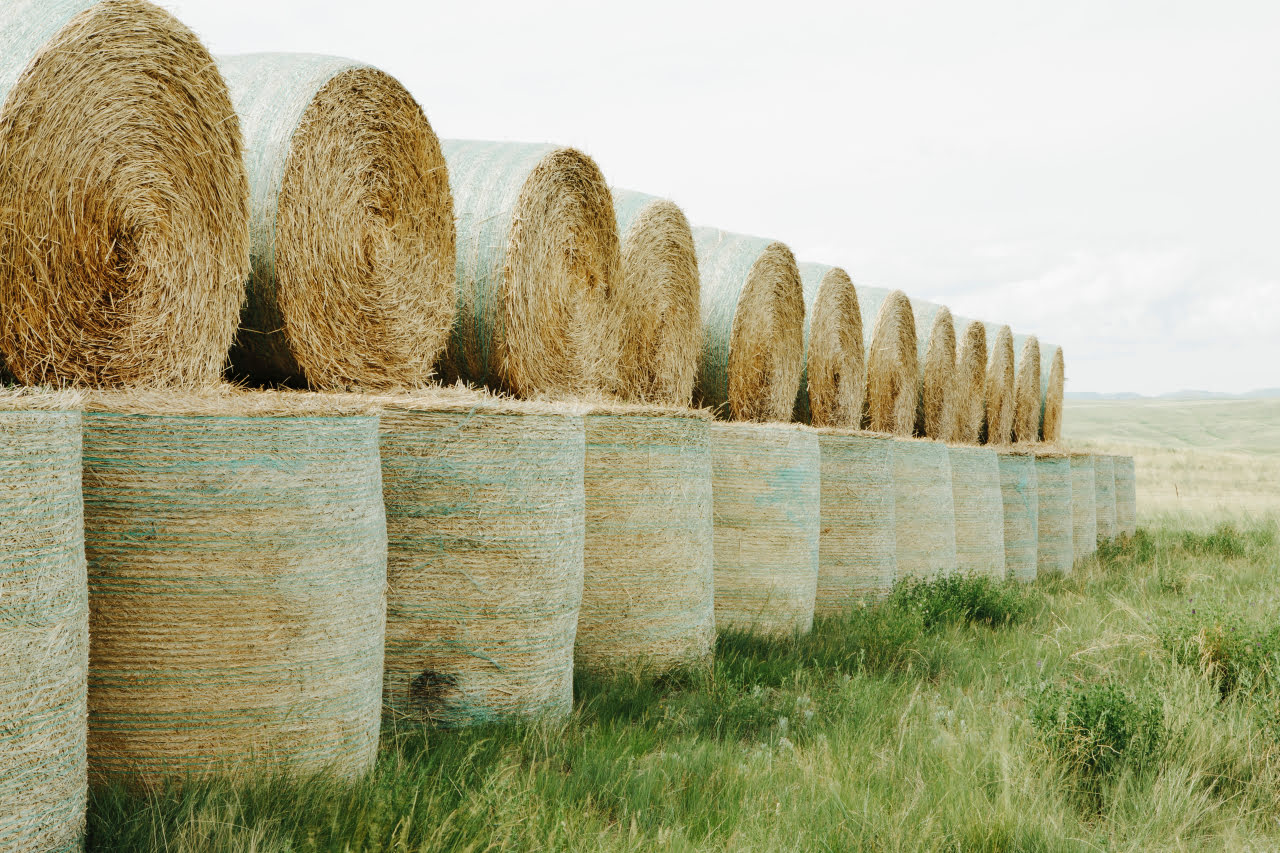There’s no denying that the bountiful Lucerne has received a whole lot of praise from cows and farmers alike for its high palatability, nutritive value, drought tolerance, perseverance during harsh winters and more.
In this article, we’re going to be talking all about Lucerne as silage and how to make silage while the sun shines!
Nutritive Value:
When compared to other forages like sorghum, oats and corn, Lucerne has higher amounts of crude protein (CP), calcium (Ca) and phosphorous (P). But it has lower total digestible nutrients.

How ensiling works:
For plants that have high amounts of readily fermentable carbs, like corn, the ensilage process happens without any additional carbohydrates.
Lucerne, on the other hand, requires supplemental carbohydrates for proper fermentation.
When Lucerne is harvested, the forage is still teeming with life. The plant enzymes and aerobic bacteria present will rapidly begin to use up the available carbohydrates to produce heat and carbon dioxide. Over time this decreases the carbs.
We need to encourage the growth of anaerobic bacteria to produce lactic, acetic and propionic acids which then preserve the forage as silage. That’s why Lucerne silages need more carbs, added into the mix.
The anaerobic bacteria produce organic acids that in turn reduce the pH levels to 4.2 or below. Such low pH levels stop the any further growth of bacteria and enzymes.
This entire process of ensiling takes about 2 – 3 weeks.
Advantages of harvesting Lucerne as silage:
By ensiling Lucerne, you can avoid pasture bloat and wastage. Let’s discuss both.
As you know grazing Lucerne can cause pasture bloat. Especially, when your cows graze Lucerne forages in its early bloom stages. But by harvesting only mature Lucerne for silage, you significantly reduce chances of pasture bloat.
Also, this way, you have more control of how much Lucerne silage you want to add as part of your total cattle feed.
You also avoid wastage due to wilting. As you know, Lucerne can at times begin to wilt quickly.
While practicing rotational grazing, it’s almost impossible to align your grazing schedules to match peak DM targets across all your Lucerne paddocks.
Sometimes, this can mean significant Lucerne dry matter losses, due to wilting. But harvesting Lucerne for silage completely eliminates this loss.

How to harvest:
Control the dry matter content:
As soon as it’s mowed, Lucerne tends to lose its sugars. These sugars are the main food of fermentation bacteria. The key to high-quality Lucerne silage is to dry the crop to the proper DM level for ensiling in the storage facility as soon as possible.
If Lucerne is ensiled when it is too wet, the fermentation becomes prolonged which results in a loss of DM and a high acid load. There could also be a chance of clostridial fermentation.
In simple words, it can create an ideal habitat for the bad guys like Clostridium butyricum, Clostridium beijerinckii and Clostridium tyrobutyricum . A foul smell often indicates clostridial fermentation. This is undesirable.
Proper moisture content can be assessed by doing a quick grab test.
Wring out a handful of moisture and then study the ball that’s left behind in your hand. It should fall apart slowly with no liquids coming out of it.
You can judge the approximate moisture content based on the state of the ball.
- If the ball holds shape with a lot of liquid then the moisture content would be approximately over 75%.
- If the ball holds shape with a little liquid then the moisture content would be around 70%.
- If the ball falls apart slowly with no liquid then the moisture content is around 60% .
- If the ball falls apart quickly then the moisture content is below 60%.
Ideally, you want your Lucerne silage to have a moisture content of around 60%.
On the other hand, if the ensiling Lucerne is too dry, then packing it becomes a task. The trapped air causes an increase in plant respiration and produces a lot of heat.
And this increases the growth of aerobic microbes like molds. Which in turn decreases the amount of protein in the silage, thus giving the animals a feed that is not very nutritious.
Adding additives based on moisture:
If the Lucerne you’re ensiling comprises more than 65 percent moisture, then feed additives and chemical preservatives are a must.
You can use ground corn, barley, wheat, oats, or molasses to provide the additional carbohydrates, necessary for fermentation. Mineral acids like formic, propionic and lactic acid can be used as alternative ways to reduce the pH.
Sodium metabisulate has shown good results in stopping the growth of unwanted bacteria.
The first few hours of the process are very crucial.
If the forage is exposed to air for a long time, the readily available carbohydrates will disappear. This inhibits the production of lactic acid and causes a high pH that deteriorates the plant material.
Height to chop:
Lucerne can be cut around 8 cm height for maximum DM and nutrients. Roller conditioners can be used to accelerate the wilting process.
At above 30% DM, do not cut more than 1.5 cm. At a level below 30% DM, the risk of spoilage is much lesser and therefore a higher chop length like say around 5 cm can be used.
Mowing:
When you leave the mowed forage in wide swaths, it dries faster and the plant sugars stay put to some level.
Cutting Lucerne in the afternoon after a bright and sunny day results in higher forage sugar levels but be warned, if this forage remains in the windrow for a long time, then a lot of the sugars get lost.

Packing:
The silage should be packed tightly in an anaerobic environment after harvesting so that DM loss is reduced. Silage porosity is determined by the packing density and DM content.
The minimum pack density for Lucerne silage is 200-250 kg DM/metre cube or in other words, a porosity level that’s less than 40%.

Avoiding contamination:
Contamination is always a possibility in Lucerne silage. An excess of ash can spoil the silage by increasing the risks of fermentation. Here are some useful tips to help reduce contamination by ash which should be below 10%:
- Harvest early
- Plant varieties that stand better
- Use flat knives while harvesting
- Keep windrow off the ground
- Keep rake tines from touching the ground
- Minimise the horizontal movement of hay
- Use windrow mergers
- Store silage on concrete or asphalt
Steps in making silage:
- At late bud or the early bloom stage of maturity – swath, condition and windrow
- Allow it to dry at 60% - 70% moisture
- Chop the forage from 2 – 5 inches in length
- Add available carbohydrates or preservatives to the high-moisture silage
- Fill the silo or bunker immediately and pack thoroughly
- Use a seal to make it airtight
- Let it lie there. Do not keep checking on it. Only open when ready to use!
Getting the Lucerne silage just right is an exact science. One that’s directly tied to the quality and quantity of that liquid gold your cows produce that keeps your farm thriving. Lucerne harvested when too mature can result in adecrease in milk production.
At the same time, Lucerne silage with high amounts of potassium increased the milk yield in high-producing cows. Lucerne is great for high producing cows because of the high content of protein and high passage rate through the gut during early lactation.
In general, Lucerne silage is loved by dairy producers because the cows truly relish it. Studies have shown that on a dry matter basis, cows eat more silage than hay.
That brings us to the end of this article.
If you enjoyed this, you might find our free guide on Pasture Grazing Management useful.
- The Dedicated Team of Pasture.io, 2021-02-08